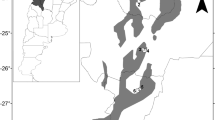Abstract
We list the animal species, mushrooms and honey, which are consumed by bonobos (Pan paniscus)in the Ikela region (Lilungu), Republic of Zaire, and compare these data with those obtained from other populations of bonobos: Lomako, Yalosidi, and Wamba. Lilungu bonobos consume earthworms more regularly than bonobos do at other localities. They also eat larvae, termites, and ants, but they probably do not consume invertebrates as regularly as chimpanzees do. Lilungu bonobos ate a squirrel and a chiropteran. We report our detailed observations of bonobo foraging, feeding and manipulating foods, including washing some items and complicated handling operations. We note intra- and intergroup differences in the consumption of specific foods and in the way they are handled by the females.
Similar content being viewed by others
References
Altmann, J. (1974). Observational study of behaviour: Sampling methods.Behaviour 49: 227–267.
Badrian, N., and Malenky, R. K. (1984). Feeding ecology ofPan paniscus in the Lomako Forest, Zaire. In Susman, R. L. (ed.),The Pygmy Chimpanzee: Evolutionary Biology and Behavior, Plenum Press, New York, pp. 275–299.
Bermejo, M., and Omedes, A. (1994). Vocal communication in wild bonobos (Pan paniscus) (submitted for publication).
Boesch, C., and Boesch, H. (1981). Sex differences in the use of natural hammers by wild chimpanzees: A preliminary report.J. Hum. Evol. 10: 585–593.
McGrew, W. C. (1983). Animal foods in the diets of wild chimpanzees (Pan troglodytes): Why cross-cultural variation?J. Ethol. 1: 46–61.
McGrew, W. C., Tutin, C. E. G., and Baldwin, P. J. (1979). Chimpanzees, tools and termites: Cross-cultural comparisons of Senegal, Tanzania and Rio Muni.Man 14: 185–214.
Kano, T. (1983). An ecological study of the pygmy chimpanzees (Pan paniscus) of Yalosidi, Republic of Zaïre,Int. J. Primatol. 4: 1–31.
Kano, T., and Mulavwa, M. (1984). Feeding ecology of the pygmy chimpanzees (Pan paniscus) of Wamba. In Susman, R. L. (ed.),The Pygmy Chimpanzee: Evolutionary Biology and Behavior, Plenum Press, New York, pp. 233–274.
Susman, R. L. S. (1984). The locomotor behavior ofPan paniscus in the Lomako Forest. In Susman, R. L. (ed.),The Pygmy Chimpanzee: Evolutionary Biology and Behavior, Plenum Press, New York, pp. 369–393.
Uehara, S. (1986). Sex and group differences in feeding on animals by wild chimpanzees in the Mahale Mountains National Park, Tanzania.Primates 27(1): 1–13.
Uehara, S. (1990). Utilization patterns of a marsh grassland within the tropical rain forest by the bonobos (Pan paniscus) of Yalosidi, Republic of Zaire.Primates 31(3): 311–322.
Author information
Authors and Affiliations
Rights and permissions
About this article
Cite this article
Bermejo, M., Illera, G. & Pí, J.S. Animals and mushrooms consumed by bonobos (Pan paniscus): New records from lilungu (Ikela), Zaire. Int J Primatol 15, 879–898 (1994). https://doi.org/10.1007/BF02736074
Received:
Revised:
Accepted:
Published:
Issue Date:
DOI: https://doi.org/10.1007/BF02736074




